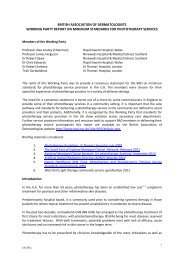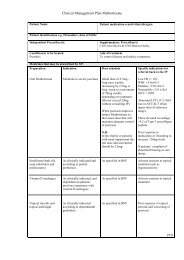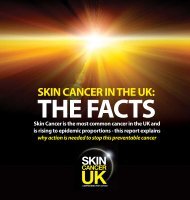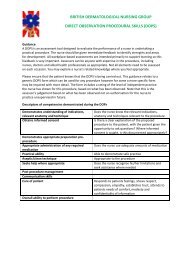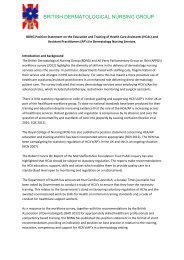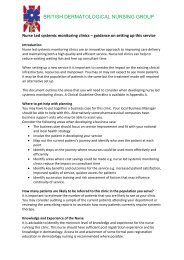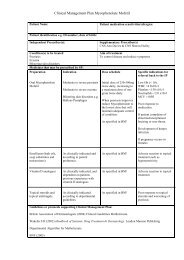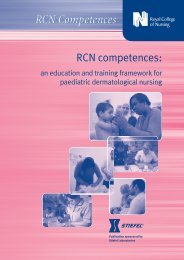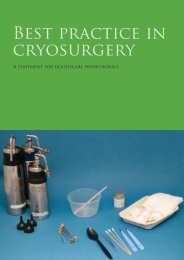Improving outcomes for people with skin tumours including melanoma
Improving outcomes for people with skin tumours including melanoma
Improving outcomes for people with skin tumours including melanoma
Create successful ePaper yourself
Turn your PDF publications into a flip-book with our unique Google optimized e-Paper software.
One observational study found that 21.8% of patients <strong>with</strong> AJCC stage<br />
I MM relapsed. The authors concluded that only clinical examination<br />
is cost-effective in the detection of metastases and recommended that<br />
follow-up should be undertaken three times a year.<br />
<strong>Improving</strong> Outcomes <strong>for</strong><br />
People <strong>with</strong> Skin Tumours<br />
<strong>including</strong> Melanoma<br />
Follow-up<br />
One observational study found that 20% of patients diagnosed <strong>with</strong><br />
stage I MM developed recurrence. Doctor-diagnosed nodal<br />
recurrences were smaller and were associated <strong>with</strong> fewer<br />
histologically positive nodes than recurrences that were detected by<br />
patients. However, subsequent survival was identical in patients <strong>with</strong><br />
recurrences detected by doctors and patients who detected<br />
recurrences themselves. Anxiety prior to clinic visits was reported by<br />
54% of patients, whereas follow-up was considered worthwhile by<br />
95% of patients.<br />
Observational study evidence suggests that between 47% and 72% of<br />
recurrent MMs are detected by patients, and between 26% and 28% of<br />
recurrent MMs are detected by doctors.<br />
Evidence from clinical guidelines based upon a systematic review<br />
concluded that follow-up of patients <strong>with</strong> MM should include clinical<br />
examination <strong>for</strong> a finite period and self-surveillance by patients<br />
throughout life.<br />
Educating patients <strong>for</strong> self-examination<br />
5<br />
In the patient survey commissioned <strong>for</strong> this guidance, patients were<br />
happy to check themselves <strong>for</strong> <strong>skin</strong> cancer having received training,<br />
although some would prefer professional follow-up because of<br />
difficulty accessing certain areas such as the head and back. With<br />
respect to hospital follow-up, patients expressed a wish that follow-up<br />
be undertaken by the same person on subsequent occasions,<br />
preferably a consultant.<br />
One RCT compared nurse education <strong>for</strong> self-per<strong>for</strong>med <strong>skin</strong><br />
examination plus provision of <strong>skin</strong> photographs <strong>with</strong> nurse education<br />
and provision of a standard brochure in patients <strong>with</strong> five or more<br />
atypical naevi, <strong>with</strong> or <strong>with</strong>out a history of <strong>melanoma</strong>. The mean<br />
group scores <strong>for</strong> knowledge, awareness and confidence increased<br />
significantly in both groups at immediate follow-up, but there were<br />
no significant differences in scores between the photography group<br />
and the brochure group.<br />
The RCT described above reported further follow-up at 4 months, and<br />
found that the teaching intervention <strong>with</strong> the photo book<br />
demonstrated a significantly greater increase in the number of patients<br />
reporting self-examination, compared to the group that received<br />
teaching and a standard brochure.<br />
Guidance on cancer services: <strong>skin</strong> <strong>tumours</strong> <strong>including</strong> <strong>melanoma</strong> 109




